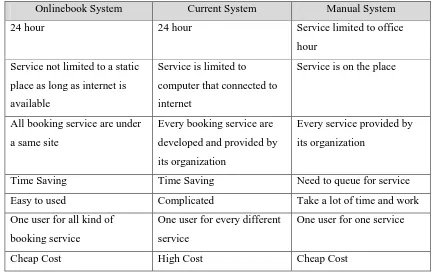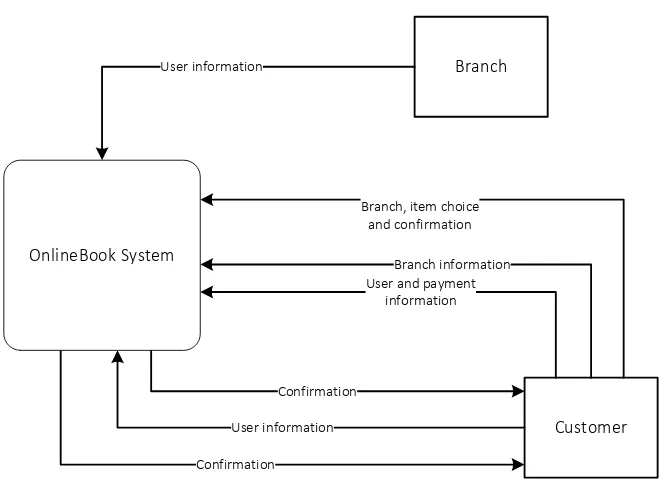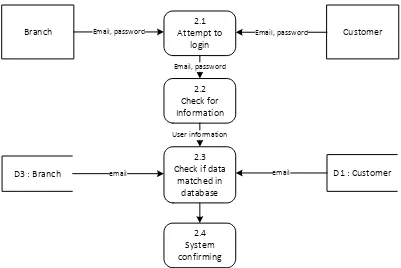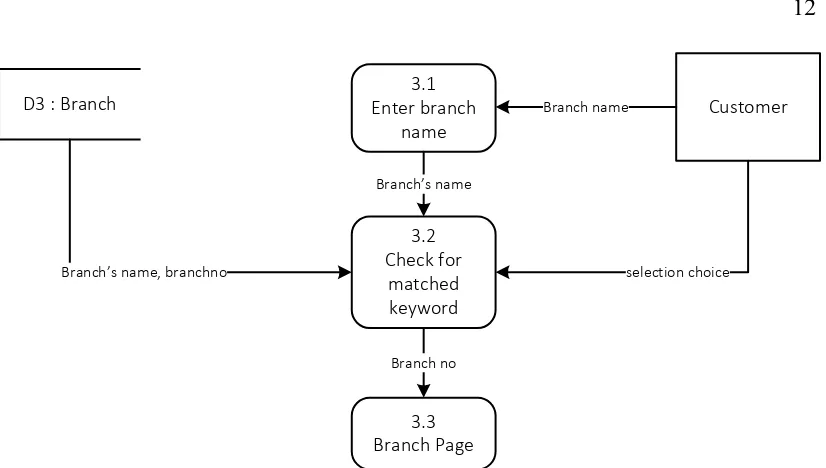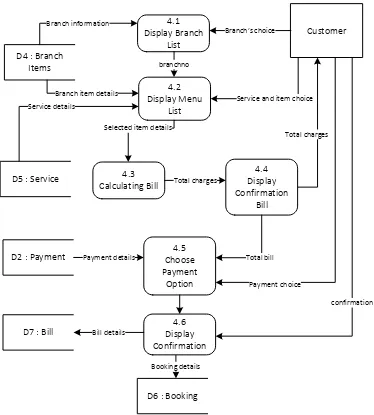ONLINEBOOK SYSTEM
IZRUL AKMAL BIN ABU HASAN
This report is submitted in partial fulfilment of the requirements for the Bachelor of Computer Science (Database Management)
FACULTY OF INFORMATION AND COMMUNICATIONS TECHNOLOGY UNIVERSITY TEKNIKAL MALAYSIA MELAKA
BORANG PENGESAHAN STATUS TESIS*
JUDUL : ____________________________________________________________ SESI PENGAJIAN: ___________________________________________________ Saya _______________________________________________________________ (HURUF BESAR)
mengaku membenarkan tesis (PSM/Sarjana/Doktor Falsafah) ini disimpan di Perpustakaan Fakulti Teknologi Maklumat dan Komunikasi dengan syarat-syarat kegunaan seperti berikut:
1. Tesis dan projek adalah hakmilik Universiti Teknikal Malaysia Melaka. 2. Perpustakaan Fakulti Teknologi Maklumat dan Komunikasi dibenarkan
membuat salinan untuk tujuan pengajian sahaja.
3. Perpustakaan Fakulti Teknologi Maklumat dan Komunikasi dibenarkan membuat salinan tesis ini sebagai bahan pertukaran antara institusi pengajian tinggi.
4. ** Sila tandakan (/)
_________ SULIT (Mengandungi maklumat yang berdarjah
keselamatan atau kepentingan Malaysia seperti yang
termaktub di dalam AKTA RAHSIA RASMI 1972)
_________ TERHAD (Mengandungi maklumat TERHAD yang telah
ditentukan oleh organisasi/badan di mana
penyelidikan dijalankan)
_________ TIDAK TERHAD
_________________________ ___________________________
(TANDATANGAN PENULIS) (TANDATANGAN PENYELIA)
Alamat tetap : _________________________ ___________________________ _____________________________________ Nama Penyelia
Tarikh : ______________________________ Tarikh : ____________________ CATATAN:
* Tesis dimaksudkan sebagai Laporan Akhir Projek Sarjana Muda (PSM)
ii
DECLARATION
I hereby declare that this project entitled ONLINEBOOK SYSTEM
Is written by me and is my own effort and that no part has been plagiarized without citation
STUDENT : ________________________________ DATE : ______________ (IZRUL AKMAL BIN ABU HASAN)
iii
DEDICATION
iv
ACKNOWLEDGEMENTS
First and foremost, I would like to take this opportunity to thank Allah, for an unlimited love and grace he gave me.
I also like to thank my dear supervisor, who also my academic advisor, En. Yahya bin Ibrahim for assisting and supervising me until the project are completed successfully. I do really appreciate the time he spent, giving me some idea and advice in order for me to create a better work. I do also appreciate the chances he gave for me to fix my problem during the project.
In addition, I would also like to thank to all my classmates, who are directly or indirectly help me to finish up this project. I appreciate all the idea, comment or criticism that are been expressed.
v
ABSTRACT
OnlineBook is a system that provides a service for all kind of booking service. It is a unification of multiple booking systems onto one huge system. It is not like any booking system you have experienced so far, as it is built to be easier and faster for consumer. “Book all in one” as tagline shows that this system is capable to handle any type of booking service.
The main reason we create this service is to provide a space for new and well-established company where they can provide a convenient and fast booking service to the customers. This system unites all the booking service under one roof. Thus, customers don’t need to make a several booking or order in different particular system. No more jumping between applications to complete a booking process, plus, within a couple of touch or clicks, all process is done.
vi
TABLE OF CONTENTS
CHAPTER I : INTRODUCTION ... 1
1.1 Project Background ... 1
1.2 Problem Statements ... 2
1.3 Objectives ... 2
1.4 Project Scope ... 3
1.5 Project Significant ... 4
1.6 Expected Output ... 5
1.7 Conclusion ... 5
CHAPTER II : ANALYSIS ... 6
2.1 Introduction ... 6
2.2 Problem Analysis ... 6
2.3 Requirement Analysis ... 7
2.3.1 Data Requirement... 7
2.3.2 Functional Requirement ... 8
2.3.3 Non-Functional Requirement ... 13
2.4 Conclusion ... 14
CHAPTER III : DESIGN ... 15
3.1 Introduction ... 15
3.2 High-Level Design ... 15
3.2.1 System Architecture ... 15
3.2.2 User Interface Design ... 16
3.2.3 Conceptual and Logical Database Design... 25
3.3 System Architecture ... 31
3.3.1 Physical Database Design (scheme level – DDL/DCL) ... 31
3.4 Conclusion ... 35
CHAPTER IV : IMPLEMENTATION ... 36
vii
4.2 Flow Chart of Onlinebook System ... 36
4.2.1 Flow Chart of the Main System ... 36
4.2.2 Flow Chart of Sub-Process: Register ... 37
4.2.3 Flow Chart of Sub-Process: Main Menu ... 41
4.2.4 Flow Chart of Sub-Process: Search ... 42
4.2.5 Flow Chart of Sub-Process: Booking ... 43
4.3 Conclusion ... 48
CHAPTER V : TESTING ... 50
5.1 Introduction ... 50
5.2 Test Strategy ... 50
5.2.1 White Box Testing ... 50
5.2.2 Black Box Testing ... 54
5.3 Conclusion ... 56
CHAPTER VI : CONCLUSION ... 57
6.1 Observation on Weakness and Strengths ... 57
6.2 System Strength and Weakness ... 57
6.3 Proposition for Improvement ... 58
6.4 Conclusion ... 58
viii
TABLE OF FIGURE
Figure 1: Context Diagram of OnlineBook System ... 9
Figure 2: Data Flow Diagram Level 0 ... 10
Figure 3: Data Flow Diagram Level 1 – Registration ... 11
Figure 4: Data Flow Diagram Level 1 - Login ... 11
Figure 5: Data Flow Diagram Level 1 - Searching ... 12
Figure 6: Data Flow Diagram Level 1 – Booking ... 13
Figure 7 : System Architecture ... 16
Figure 8 : Navigation Design ... 18
Figure 9 : Registration Page ... 19
Figure 10 : Search Page... 20
Figure 11 : Branch's Menu Page ... 21
Figure 12 : Payment Page ... 22
Figure 13 : Search Page... 23
Figure 14 : Company Page ... 24
Figure 15 : Order Summary Page... 25
Figure 16: Conceptual Database Design ... 26
Figure 17: Logical Database Design ... 27
Figure 18: Flow Chart of Main System ... 37
Figure 19: Flow Chart of Sub-Process – Registration ... 41
Figure 20 : Flow Chart of Main Menu ... 42
Figure 21 : Flow Chart of Sub-Menu – Search ... 43
Figure 22 : Flow Chart of Sub-Menu – Booking ... 48
Figure 23 : Warning box triggered as user did not input required data ... 52
Figure 24 : Message box display message of unmatched account ... 53
Figure 25 : Menu of choices ... 55
ix
LIST OF TABLES
Table 1 : Comparison between Onlinebook, Current and Manual System ... 7
Table 2 : Non-Functional Requirement ... 13
Table 3 : Logical Database Design ... 27
Table 4 : Physical Database Design ... 31
Table 5 : Stored Procedure - insertcustomer ... 38
Table 6 : Stored Procedure - getcustomerno ... 39
Table 7 : Stored Procedure - insertpayment ... 39
Table 8 : Stored procedure - branchlist ... 42
Table 9 : Stored procedure - branch-company-list ... 44
Table 10 : Stored procedure - branch-details ... 44
Table 11 : Stored procedure - branch-service ... 45
Table 12 : Stored procedure - branch-item ... 45
Table 13 : Stored procedure - paymentdetails... 46
1 CHAPTER I
INTRODUCTION
1.1 Project Background
Mobile application assist customer to book services. Based on The Sun Daily article titled “Malaysia’s smartphone rises by 16%” posted on 4 September 2013 state that Malaysia's smartphone penetration has increased by 16% points to 63% this year from 47% in 2012, while tablet penetration has increased almost three-fold to 39% from 14%, according to a recently-concluded analysis by Ericsson Consumer Lab in Southeast Asia and Oceania. This show the increase rate of smartphone user among Malaysian. In addition, people nowadays tends to use smartphone or tablet rather than using other electronic device such personal computer because its compatibleness. Besides that, it is in line with the modern lifestyle because smartphone is everything for most of the people. All the email, contacts, picture, and other data is being kept into smartphone. Smartphone nowadays are easy and convenient to use. It is fast and secure.
2 of Onlinebook System is to create a new medium for company to provide a booking service for customer. As the smartphone is very important and personal for everybody, Onlinebook system is implemented into this mobile application. So, it can be used almost everywhere that have internet connection and enhance the usage to the highest.
1.2 Problem Statements
Time is a limit for quite most of the people. They would not spend their precious time waiting for long queue to get something. They need an application that can reduce the queue as people nowadays are less forbearing with this problem. Furthermore, traditional manual booking is not twenty four hours service as most of it is limited for office hours only.
People are working, thus they doesn’t have time for booking while they are working. Next, customer needs a simple and easy booking system that is providing all-in-one booking service. Most of booking system provided in the market is complicated and difficult to use. On the other hand, newly established company are struggling to cope with the competitors. They need big budget to build a booking system for their own and also need budget to promote their system to the public.
1.3 Objectives
There are several objectives to develop Onlinebook system. Below are several of them:
3 • To help company to reduce cost for developing a booking system
• To save time of customer to book a service
1.4 Project Scope
This project is divided into two scopes. One of the scope is user scope who are using this system, and the other is system modules which are part of the Onlinebook system.
• User scope
o Customer
User that use this system to book a service available in the system
o Branch admin
User that use this system to manage service booked by customer for the specified branch
o Company admin
User that use this system to manage service booked by customer for whole branch owned by the company
• System Module
o Login
Verify the user and password for security purposed.
o Registration
4
o Search
Quick find available service in the system for user to book
o Booking and payment
Book available service provided by company and branch Select desired item offered along a service
Calculate the total charge for service booked
Pay the bill by charging into one of the payment registered
1.5 Project Significant
Onlinebook system will bring a lot of benefits to both customer and company. For customers, this system can help to save a lot of time and cost. This is because of the unification of all booking system available on the market that this system provides. User also do not need to waste time and money going to the place hopefully to gamble for a decent service that are not sure is it available or not. Moreover, they can book anytime they want as it is online and the booking process is handling by the computer.
5 1.6 Expected Output
Onlinebook system should be able to handle all sort of booking service provided by company to the customer. This system also should be able to calculate total bill charged for the service and item ordered by customer correctly including a correct government charged along with the service and item price.
1.7 Conclusion
2 CHAPTER II
ANALYSIS
2.1 Introduction
Analysis phase is where a clear view of the system that should be developed is seen. This chapter start with the problem analysis that discuss and identify the problem encounter with current and manual system nowadays. This chapter will show all of the analysis of system during observation of the problem analysis.
2.2 Problem Analysis
7 Table 1 : Comparison between Onlinebook, Current and Manual System
Onlinebook System Current System Manual System
24 hour 24 hour Service limited to office
hour
Service not limited to a static
place as long as internet is
available
Service is limited to
computer that connected to
internet
Service is on the place
All booking service are under
a same site
Every booking service are
developed and provided by
its organization
Every service provided by
its organization
Time Saving Time Saving Need to queue for service
Easy to used Complicated Take a lot of time and work
One user for all kind of
booking service
One user for every different
service
One user for one service
Cheap Cost High Cost Cheap Cost
2.3 Requirement Analysis
Requirement analysis is divided into data requirements, functional requirements and non-functional requirements. Data requirements specify a mandatory data type for the data input and output from the system. Functional requirements specifies on the function or module of the system. Non-functional requirements defines constrains criteria on how the system will do the work.
2.3.1 Data Requirement
8 Data input for customer:
• Name
• Password • Email • Birth Date • Phone number • Credit card Number
2.3.2 Functional Requirement
9 2.3.2.1 Context Diagram
Customer Branch
User information
User information Confirmation
User and payment information
Branch information
Confirmation
Branch, item choice and confirmation OnlineBook System
10 2.3.2.2 Data Flow Diagram (DFD)
Customer Branch 1.0 Registration 2.0 Login 3.0 Searching 4.0 Booking D1: Customer
User id Customer information User information User information User information Confirmation
User and payment information Matched user id
D3: Branch
User information Matched user id
Matched branch list
Search information
Branch information
Branch choosen
Confirmation Branch, item choice and confirmation D4: Branch
Items
D6: Booking
D2: Payment Branch id
Branch item list
Confirmed booking Payment details Confirmed bill D2: Payment Payment information D7: Bill D5: Service Service list
11
Customer 1.1
Fill in information
D1 : Customer custNo
User information User information Customer details 1.3 Fill in payment information 1.2
Get User Id
1.4 Confirmation D2 : Payment
Payment details
Agreement details custNo
Successful message Payment details
Figure 3: Data Flow Diagram Level 1 – Registration
Customer
D1 : Customer Email, password
2.1 Attempt to
login Branch Email, password
D3 : Branch email
2.2 Check for Information
2.3 Check if data
matched in database 2.4 System confirming email Email, password User information
12
Customer 3.1
Enter branch name D3 : Branch
Branch’s name, branchno
Branch name
3.2 Check for
matched keyword
3.3 Branch Page
Branch’s name
Branch no
selection choice
13
Customer
Total charges Branch’s choice
D4 : Branch Items
D6 : Booking D2 : Payment
Branch information
Branch item details
Booking details Payment details 4.1 Display Branch List 4.2 Display Menu List 4.3 Calculating Bill 4.4 Display Confirmation Bill 4.5 Choose Payment Option 4.6 Display Confirmation branchno
Selected item details
Total charges
Total bill
confirmation Payment choice
D7 : Bill Bill details D5 : Service
Service details
Service and item choice
Figure 6: Data Flow Diagram Level 1 – Booking
2.3.3 Non-Functional Requirement
Non-functional requirement defines constrains possesses by Onlinebook System. There are several non-functional requirement possesses by Onlinebook System.
Table 2 : Non-Functional Requirement
REQUIREMENT DESCRIPTION
14
and operating system without having customer or company to
install it inside the hardware.
Availability Onlinebook are always available because it is install inside
the Microsoft server.
Disaster recovery All the data are safe if the specific company or branch are
facing human or natural disaster because the system are not
implement into a physical computer of the company
Efficiency All sorts of booking service are handle efficiently through the
server. Thus, there is no problem to handle big load of data
on a time
Effectiveness All calculation of the bill are correctly calculated
Price The price charged for customer and company are very cheap
thus it is not burden anyone
Portability Onlinebook can be open in all kinds of browser whether in
mobile phone, tablet, or PC but mobile phone are
recommended due to graphic design.
Reliability Onlinebook should no bug during data transmission
Security Online authenticated user can log in into the system. All
transaction are secured
Usability Interface are very easy to use thus cut time for user to
complete transaction
2.4 Conclusion
